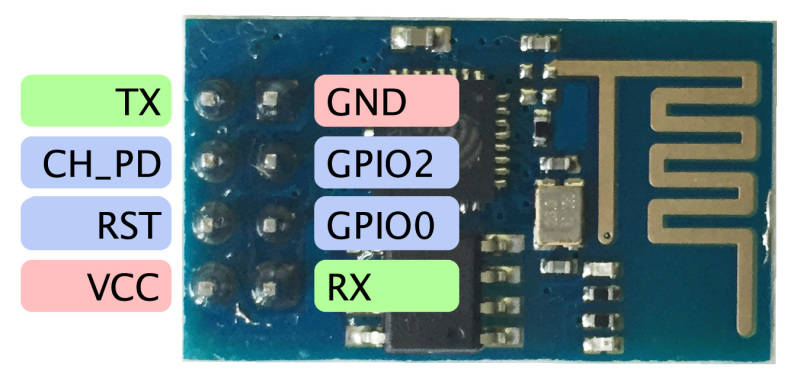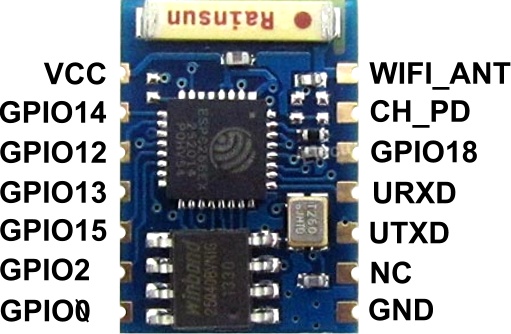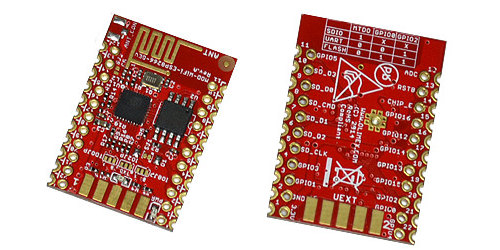
|
ESP8266-DEVKITC-02D-FEspressif Systems
|
x 1 | |
|
|
USB-A-S-F-B-VTSamtec
|
x 1 | |

|
741C083510JPCTS Resistor Products
|
x 1 | |

|
106SML035MD4Illinois Capacitor
|
x 1 | |

|
C503B-RAN-CZ0A0AA2Cree LED
|
x 1 | |

|
AMS1117-5 |
x 1 |

|
arduino IDEArduino
|
Esp8266 Standlone
What is the "Internet of things"?
The Internet of things (IoT) is the network of everyday objects — physical things embedded with electronics, software, sensors, and connectivity enabling data exchange. Basically, a little networked computer is attached to a thing, allowing information exchange to and from that thing. Be it lightbulbs, toasters, refrigerators, flower pots, watches, fans, planes, trains, automobiles, or anything else around you, a little networked computer can be combined with it to accept input (especially object control) or to gather and generate informational output (typically object status or other sensory data). This means computers will be permeating everything around us — ubiquitous embedded computing devices, uniquely identifiable, interconnected across the Internet. Because of low-cost, networkable microcontroller modules, the Internet of things is really starting to take off.

What is ESP8266?
The Chips
The ESP8266 series, or family, of Wi-Fi chips is produced by Espressif Systems, a fabless semiconductor company operating out of Shanghai, China. The ESP8266 series presently includes the ESP8266EX and ESP8285 chips.
ESP8266EX (simply referred to as ESP8266) is a system-on-chip (SoC) which integrates a 32-bit Tensilica microcontroller, standard digital peripheral interfaces, antenna switches, RF balun, power amplifier, low noise receive amplifier, filters and power management modules into a small package. It provides capabilities for 2.4 GHz Wi-Fi (802.11 b/g/n, supporting WPA/WPA2), general-purpose input/output (16 GPIO), Inter-Integrated Circuit (I2C), analog-to-digital conversion (10-bit ADC), Serial Peripheral Interface (SPI),

I2S interfaces with DMA (sharing pins with GPIO), UART (on dedicated pins, plus a transmit-only UART can be enabled on GPIO2), and pulse-width modulation (PWM). The processor core, called "L106" by Espressif, is based on Tensilica's Diamond Standard 106Micro 32-bit processor controller core and runs at 80 MHz (or overclocked to 160 MHz). It has a 64 KiB boot ROM, 32 KiB instruction RAM, and 80 KiB user data RAM. (Also, 32 KiB instruction cache RAM and 16 KiB ETS system data RAM.) External flash memory can be accessed through SPI. The silicon chip itself is housed within a 5 mm × 5 mm Quad Flat No-Leads package with 33 connection pads — 8 pads along each side and one large thermal/ground pad in the center.

The ESP8266 is a low-cost Wi-Fi microchip, with built-in TCP/IP networking software, and microcontroller capability, produced by Espressif Systems in Shanghai, China.
The chip first came to the attention of Western makers in August 2014 with the ESP-01 module, made by a third-party manufacturer Ai-Thinker. This small module allows microcontrollers to connect to a Wi-Fi network and make simple TCP/IP connections using Hayes-style commands. However, at first, there was almost no English-language documentation on the chip and the commands it accepted.
The very low price and the fact that there were very few external components on the module, which suggested that it could eventually be very inexpensive in volume, attracted many hackers to explore the module, the chip, and the software on it, as well as to translate the Chinese documentation.

The ESP8285 is a similar chip with a built-in 1 MiB flash memory, allowing the design of single-chip devices capable of connecting via Wi-Fi.
These microcontroller chips have been succeeded by the ESP32 family of devices.
The Modules
Vendors have consequently created a multitude of compact printed circuit board modules based around the ESP8266 chip. Some of these modules have specific identifiers, including monikers such as "ESP-WROOM-02" and and "ESP-01" through "ESP-14"; while other modules might be ill-labeled and merely referred to by a general description — e.g., "ESP8266 Wireless Transceiver." ESP8266-based modules have demonstrated themselves as a capable, low-cost, networkable foundation for facilitating end-point IoT developments. Espressif's official modules are presently ESP-WROOM-02 and ESP-WROOM-S2. The Ai-Thinker modules are succinctly labeled ESP-01 through ESP-14. (Note: many people refer to the Ai-Thinker modules with the unofficial monikers of "ESP8266-01" through "ESP8266-14" for clarity.) See the ESP8266 article on Wikipedia for more information about popular ESP8266 modules.

Technical Features
802.11 b / g / n
Wi-Fi Direct (P2P), soft-AP
Built-in TCP / IP protocol stack
Built-in TR switch, balun, LNA, power amplifier and matching network
Built-in PLL, voltage regulator and power management components
802.11b mode + 19.5dBm output power
Built-in temperature sensor
Support antenna diversity
off leakage current is less than 10uA
Built-in low-power 32-bit CPU: can double as an application processor
SDIO 2.0, SPI, UART
STBC, 1×1 MIMO, 2×1 MIMO
A-MPDU, A-MSDU aggregation and the 0.4 Within wake
2ms, connect and transfer data packets
standby power consumption of less than 1.0mW (DTIM3)
Variants
ESP8266-based boards are available from several vendors and with different breakout boards. Most of the boards differ in the number of pins made available, the amount of Flash memory for storing program and data, and the shielding on the SOC for certified boards.
Some boards also support an external uFL antenna connector as well as the buil-in on-chip antenna.
The most common variants are:
ESP-01

This is the first and simplest board using the ESP8266. It allows to attach serial lines, and only breaks out two GPIO pins for native usage. This is also the cheapest and can be purchased from many chinese suppliers at 2.5 dollars.
ESP-03

This is the second generation board, breaking out more GPIO pins, and using a different antenna, plus an external antenna connector.
Olimex ESP8266 Eval Board

This board, produced by Olimex, breaks out all the ESP8266 pins in breadboard headers, but can also be soldered as a module.
It contains 2Mb of flash memory, four times that available on the ESP-01 and ESP-03, for larger firmware and space for files useful to make a webserver.
Using the ESP8266 with Arduino
Several Libraries have been developed to use ESP8266 as a module for Arduinos.
Also there is a port of the Arduino IDE for programming the ESP Directly, see below.
Using the ESP8266 via Serial port
You can interact with the ESP8266 sending AT Commands via the provided TX and RX pins by using another microcontroller.
Pay attention to the voltage of your signal lines, as the ESP8266 only works with 3.3v and pins are not 5V tolerant.
I.e. if you want to attach it to an Arduino clone you must use a logic level converter such as this .
An alternative to the logic level converter is to build a voltage divider circuit for each
signal line.
Programming the ESP8266 Directly
In order to program the ESP directly you need to install a toolchain and firmware upload utility.
The ESP8266 Wiki explains the process in detail.
You should use the ESP Open SDK to build your toolchain.
Espressif also provides an SDK containing the AT Firmware and the proprietary libraries.


Esp8266 Standlone
*PCBWay community is a sharing platform. We are not responsible for any design issues and parameter issues (board thickness, surface finish, etc.) you choose.
- Comments(0)
- Likes(0)
- 0 USER VOTES
- YOUR VOTE 0.00 0.00
- 1
- 2
- 3
- 4
- 5
- 6
- 7
- 8
- 9
- 10
- 1
- 2
- 3
- 4
- 5
- 6
- 7
- 8
- 9
- 10
- 1
- 2
- 3
- 4
- 5
- 6
- 7
- 8
- 9
- 10
- 1
- 2
- 3
- 4
- 5
- 6
- 7
- 8
- 9
- 10
 More by Sreeram.zeno
More by Sreeram.zeno
-
 Esp12-F Cluster V1.0
The ESP8266 is a low-cost Wi-Fi microchip, with built-in TCP/IP networking software, and microcontro...
Esp12-F Cluster V1.0
The ESP8266 is a low-cost Wi-Fi microchip, with built-in TCP/IP networking software, and microcontro...
-
 TB6612FNG Motor Driver
The TB6612FNG Motor Driver can control up to two DC motors at a constant current of 1.2A (3.2A peak)...
TB6612FNG Motor Driver
The TB6612FNG Motor Driver can control up to two DC motors at a constant current of 1.2A (3.2A peak)...
-
 Sunny Buddy Solar Charger v1.0
This is the Sunny Buddy, a maximum power point tracking (MPPT) solar charger for single-cell LiPo ba...
Sunny Buddy Solar Charger v1.0
This is the Sunny Buddy, a maximum power point tracking (MPPT) solar charger for single-cell LiPo ba...
-
 Diy 74HC4051 8 Channel Mux Breakout Pcb
The 74HC4051; 74HCT4051 is a single-pole octal-throw analog switch (SP8T) suitable for use in analog...
Diy 74HC4051 8 Channel Mux Breakout Pcb
The 74HC4051; 74HCT4051 is a single-pole octal-throw analog switch (SP8T) suitable for use in analog...
-
 Diy RFM97CW Breakout Pcb
IntroductionLoRa? (standing for Long Range) is a LPWAN technology, characterized by a long range ass...
Diy RFM97CW Breakout Pcb
IntroductionLoRa? (standing for Long Range) is a LPWAN technology, characterized by a long range ass...
-
 ProMicro-RP2040 Pcb
The RP2040 is a 32-bit dual ARM Cortex-M0+ microcontroller integrated circuit by Raspberry Pi Founda...
ProMicro-RP2040 Pcb
The RP2040 is a 32-bit dual ARM Cortex-M0+ microcontroller integrated circuit by Raspberry Pi Founda...
-
 Serial Basic CH340G Pcb
A USB adapter is a type of protocol converter that is used for converting USB data signals to and fr...
Serial Basic CH340G Pcb
A USB adapter is a type of protocol converter that is used for converting USB data signals to and fr...
-
 Mp3 Shield For Arduino
Hardware OverviewThe centerpiece of the MP3 Player Shield is a VS1053B Audio Codec IC. The VS1053B i...
Mp3 Shield For Arduino
Hardware OverviewThe centerpiece of the MP3 Player Shield is a VS1053B Audio Codec IC. The VS1053B i...
-
 MRK CAN Shield Arduino
The CAN-BUS Shield provides your Arduino or Redboard with CAN-BUS capabilities and allows you to hac...
MRK CAN Shield Arduino
The CAN-BUS Shield provides your Arduino or Redboard with CAN-BUS capabilities and allows you to hac...
-
 AVR ISP Programmer
AVR is a family of microcontrollers developed since 1996 by Atmel, acquired by Microchip Technology ...
AVR ISP Programmer
AVR is a family of microcontrollers developed since 1996 by Atmel, acquired by Microchip Technology ...
-
 Diy Arduino mega Pcb
The Arduino Mega 2560 is a microcontroller board based on the ATmega2560. It has 54 digital input/ou...
Diy Arduino mega Pcb
The Arduino Mega 2560 is a microcontroller board based on the ATmega2560. It has 54 digital input/ou...
-
 Max3232 Breakout Board
MAX3232 IC is extensively used for serial communication in between Microcontroller and a computer fo...
Max3232 Breakout Board
MAX3232 IC is extensively used for serial communication in between Microcontroller and a computer fo...
-
 Line Follower Pcb
The Line Follower Array is a long board consisting of eight IR sensors that have been configured to ...
Line Follower Pcb
The Line Follower Array is a long board consisting of eight IR sensors that have been configured to ...
-
 HMC6343 Accelerometer Module
The HMC6343 is a solid-state compass module with tilt compensation from Honeywell. The HMC6343 has t...
HMC6343 Accelerometer Module
The HMC6343 is a solid-state compass module with tilt compensation from Honeywell. The HMC6343 has t...
-
 RTK2 GPS Module For Arduino
USBThe USB C connector makes it easy to connect the ZED-F9P to u-center for configuration and quick ...
RTK2 GPS Module For Arduino
USBThe USB C connector makes it easy to connect the ZED-F9P to u-center for configuration and quick ...
-
 Arduino Explora Pcb
The Arduino Esplora is a microcontroller board derived from the Arduino Leonardo. The Esplora differ...
Arduino Explora Pcb
The Arduino Esplora is a microcontroller board derived from the Arduino Leonardo. The Esplora differ...
-
 Diy Stepper Motor Easy Driver
A motor controller is a device or group of devices that can coordinate in a predetermined manner the...
Diy Stepper Motor Easy Driver
A motor controller is a device or group of devices that can coordinate in a predetermined manner the...
-
 Diy Arduino Pro Mini
The Arduino Pro Mini is a microcontroller board based on the ATmega168 . It has 14 digital input/out...
Diy Arduino Pro Mini
The Arduino Pro Mini is a microcontroller board based on the ATmega168 . It has 14 digital input/out...
-
MPL3115A2 Barometric Pressure, Altitude, and Temperature Sensor
22 0 0 -
-
Nintendo 64DD Replacement Shell
130 0 1 -
V2 Commodore AMIGA USB-C Power Sink Delivery High Efficiency Supply Triple Output 5V ±12V OLED display ATARI compatible shark 100W
232 4 1 -
How to measure weight with Load Cell and HX711
361 0 3 -
-
Instrumentation Input, high impedance with 16 bit 1MSPS ADC for SPI
498 0 0



















































